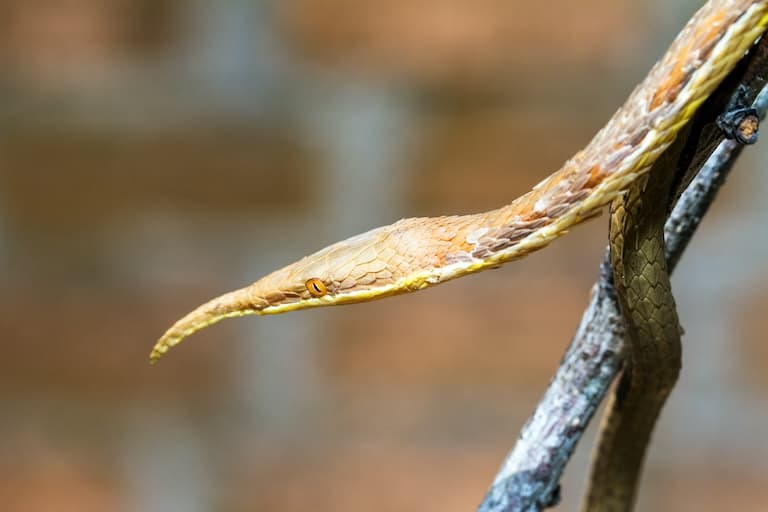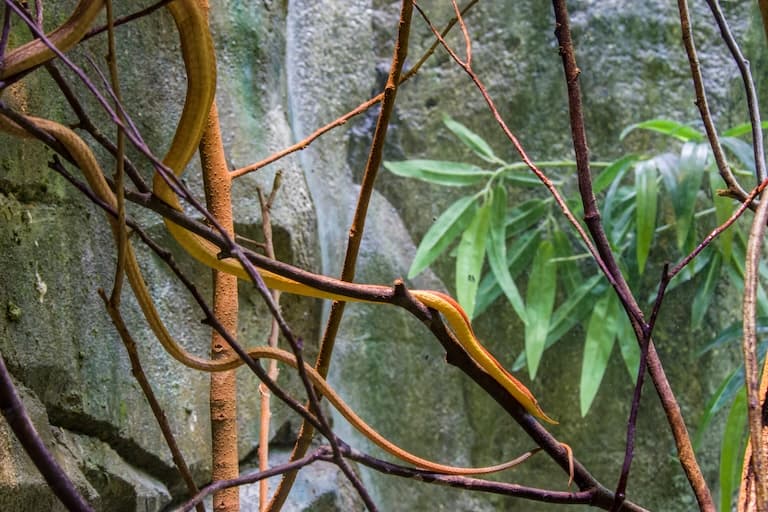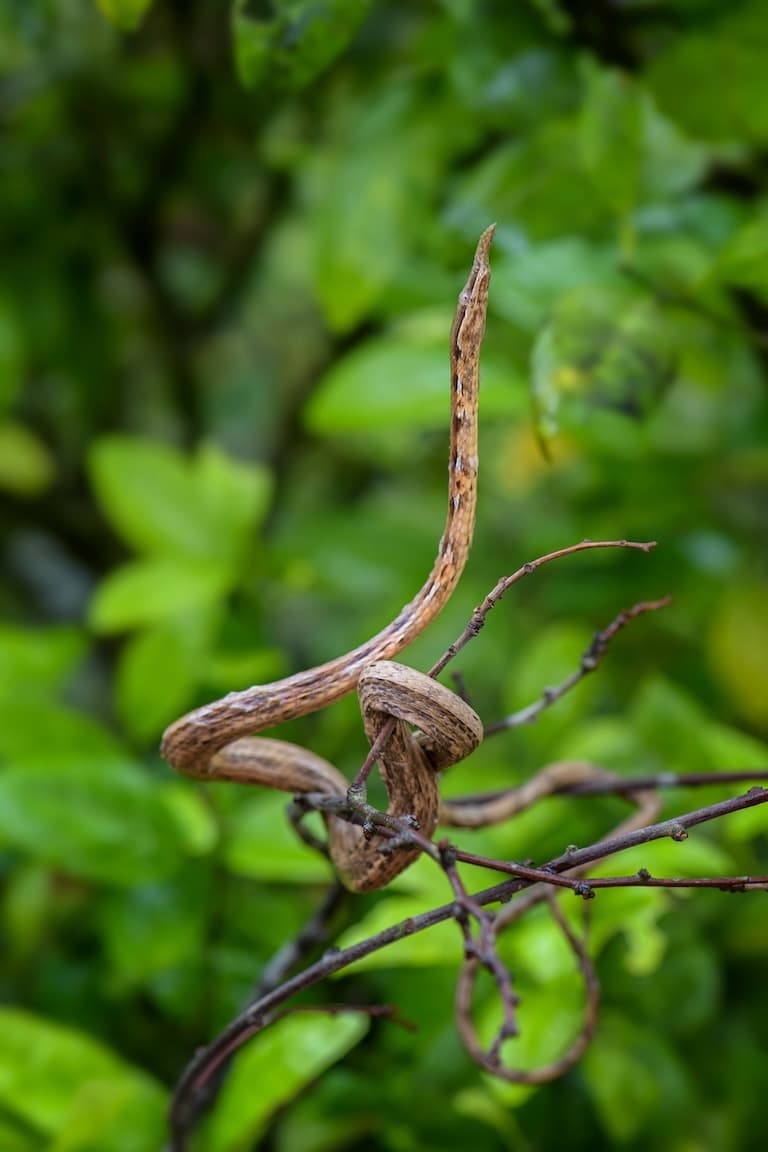Madagascar Leaf-nosed Snake Profile
Humans haven’t been regularly predated upon by snakes since before humans existed, and frankly, that’s great.
But it’s worth recognising our privilege in that regard by taking a moment to imagine life as a Madagascan lizard, ambling about, minding your own business looking for beetles, when you brush up against an innocuous little leaf, hanging at the end of a vine, swaying gently in the salty coastal breeze.
Only this isn’t a leaf at all, nor is it a vine. it’s the Madagascan leaf-nosed snake, here to ruin your day.

Madagascar Leaf-nosed Snake Facts Overview
| Habitat: | Humid and dry lowland forest |
| Location: | Madagascar |
| Lifespan: | Unknown |
| Size: | Up to 1 m (3ft) long |
| Weight: | Not reported |
| Colour: | Males are brown on the back, yellow on the belly; females more mottled |
| Diet: | Mostly lizards |
| Predators: | Larger snakes, raptors |
| Top Speed: | Slow |
| No. of Species: | 1 |
| Conservation Status: | Least Concern |
Lizards on Madagascar have to contend with a lot. Not least is this guy, a twine-shaped, leaf-faced ambush predator hanging invisibly from trees, looking like vegetation.
But this is one dangerous vegetable. Not only are they exceptionally camouflaged, these rear-fanged snakes pack a small punch – more than enough to drop a prey animal or cause a researcher a couple of days of discomfort.
These cool, skinny snakes are members of a very strange genus, known for their variations in reproductive strategies and sexual dimorphism. But after that, there’s not a lot of information about them.
Interesting Madagascar Leaf-nosed Snake Facts
1. They’re not Colubrids
Out of date literature describes this species as a nonvenomous colubrid, both of which turned out to be false.
One of these updates is more worrying than the other, given that it apparently only takes a lack of experience to declare a snake nonvenomous, but we’ll come back to that shortly.
This species is an unusual animal in that it’s a member of the Pseudoxyrhophiidae of snakes. These are all found on Madagascar and were once grouped in with the mainland family of Lamprophiidae, but have since been given their own group.
They are much closer to Elapids than Colubrids, the former being the cobras and all the scary Australian species, and the latter being the largest family of snakes there is.
Leaf-nosed snakes are considered elapoid snakes, sharing a superfamily with elapids. And like the most notorious elapids, they’re also venomous. 1

2. They’re venomous
This species is said to be reluctant to bite and very docile to be around (as long as you’re not a lizard) and for some reason it appears that this was enough to declare it nonvenomous. But one paper described the effects of envenomation on a person by this species, and fortunately, it’s not so bad.
Once thought to constrict its prey, one paper noted that there was no difference in time to death between squeezed lizards and those that just sort of hung in the snake’s mouth, and the implication of venom was corroborated by a researcher who was bitten on the finger by one.
In the classic, rear-fanged snake way, the animal chewed on the finger for some time, feeding it towards the back of its mouth for around 30 seconds while the guy just stood there watching, before sharp pain arrived and he chose to get the damn thing off his finger.
The pain was enough to get him out of doing any more work, but it reduced a lot after an hour and swelling, throbbing and tenderness continued with no signs of systemic symptoms for a couple of days. 2
3. They’re ambush predators
This venom is not much against a giant ape but it’s more than plenty for the terrestrial and arboreal lizards that make up this snake’s diet.
The snake has been said to hunt actively at times but is primarily known to sit in wait, using its incredible vine-like mimicry and forest colours to blend into the background.
When moving, they’ll even hood up their necks and sway back and forth like a plant being moved by the breeze. These are highly camouflaged snakes with a leaf for a face, so they hide well.
But this leaf may be more than just for camouflage. Researchers are still trying to figure out how much more. 3

4. They lay eggs
There is a surprising amount of variation in this genus regarding things that don’t usually vary within genera, such as reproductive modes.
One of the six or so species gives birth to live young, three lay eggs, and at least two keep their birthing habits under wraps entirely. The Madagascar leaf-nosed snake is an egg-layer. 4
5. They’re sexually dimorphic
Males and females both have an extended leafy appendage on their faces that give them their nicknames. But strangely, these appendages aren’t the same for both sexes.
Females sport the leaviest noses, with ridged, flat protrusions sticking out of their heads. Males have a straighter, narrower appendage, and the species is said to be one of the most sexually dimorphic of all snakes because of this.
They’re also both different colours from one another, with the female distinctly more dappled than the more vibrant and two-toned male.
As for the noses, nobody has figured them out, yet.
6. Why the long face?
Researchers seem to be pretty certain that there’s more to the leaf than meets the eye, but testable hypotheses are thin on the ground.
The leaf may double up as a hunting aid, as the snake is described as sometimes getting so close to its prey before striking that the leaf actually touches it.
But the sexual dimorphism in the nasal appendage suggests that there’s a sex-selected element too, and if it were purely camouflage or a hunting aid, it’s assumed that it would be the same for both sxes.
These snakes seem to have a habit of hanging vertically from branches, just chilling, leaf-down, in the forest until morning, raising more questions.

Madagascar Leaf-nosed Snake Fact-File Summary
Scientific Classification
| Kingdom: | Animalia |
| Phylum: | Chordata |
| Class: | Reptilia |
| Order: | Squamata |
| Family: | Pseudoxyrhophiidae |
| Genus: | Langaha |
| Species: | nasuta |
Fact Sources & References
- Hussam Zaher (2019), “Large-scale molecular phylogeny, morphology, divergence-time estimation, and the fossil record of advanced caenophidian snakes (Squamata: Serpentes)”, PubMed Central.
- J. Venom (2008), “Envenomation by the Malagasy colubrid snake Langaha madagascariensis”, SciELO Brazil.
- Kenneth L. Krysko (2010), “Feeding behaviour of the Madagascar leaf‐nosed snake, Langaha madagascariensis (Serpentes: Colubridae: Pseudoxyrhophiinae), with an alternative hypothesis for its bizarre head structure”, Taylor & Francis Online.
- Kenneth L. Krysko (2002), “Reproduction in the Madagascar leaf‐nosed snake, langaha madagascariensis (Serpentes: Colubridae: Pseudoxyrhophiinae)”, Taylor & Framcis.
